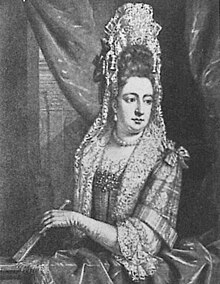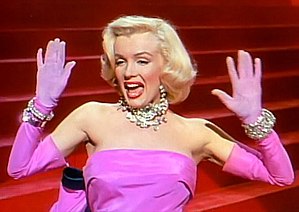Evening glove
This articleneeds additional citations forverification.(December 2009) |

Evening glovesoropera glovesare a type offormalglovethat reaches beyond theelbowworn by women.
Women's gloves for formal and semi-formal wear come in three lengths for women:wrist,elbow,andoperaor full-length (over the elbow, usually reaching to thebicepsbut sometimes to the full length of the arm).
The most expensive full-length gloves are custom-made ofkidskin.Many other types ofleather,most usually soft varieties ofcowhide,are used in making full-length gloves;patent leatherandsuedeare especially popular as alternatives to kidskin, and are often more affordable than kidskin.Satinand stretch satin materials are extremely popular, and there are mass-produced varieties as well. More unusual glove materials include leathers made from salmon, Python, and stingray.[1]
History

Western world
While the etymology of the termopera gloveis unknown, gloves of above-the-elbow length have been worn since at least the late 18th century, and gloves reaching to or just below the elbow have been worn by women in Western countries since the 17th century; in an extant engraving of England'sQueen Marydating from the 1690s she is shown wearing elbow-length gloves. Over-the-elbow gloves were first widely popular during theRegency/Napoleonicperiod (circa 1800–1825), and waned in popularity during the early and mid-Victorian periods (circa 1830–1870), but enjoyed their greatest vogue in the last two decades of the 19th century and the years of the 20th century prior to the start ofWorld War I.During that period, they were standard for both daytime and evening wear; even some swimming costumes were accessorized with opera gloves.Etiquetteconsidered gloves to be mandatory accessories for both men and women of the upper classes, so it was uncommon to see a well-dressed woman at a public occasion who was not wearing gloves of some sort. According to several fashion historians, over-the-elbow gloves were re-popularized during the late 19th century by actressesSarah Bernhardtin France (to disguise what she considered her overly thin arms) andLillian Russellin the United States.[2]

The opera glove has enjoyed varying popularity in the decades sinceWorld War I,being most prevalent as a fashion accessory in the 1940s through the early 1960s, but continues to this day to be popular with women who want to add a particularly elegant touch to their formal attire. They have enjoyed minor revivals in fashion design on several occasions, being popular inhaute couturecollections in the late 2000s.[2]Opera gloves continue to be highly popular accessories forbridal,prom,debutante,andquinceañeragowns and at very formalballroom dances(white opera gloves are still mandatory for female debutantes at theVienna Opera Ball[3]).
They are sometimes worn by entertainers such ascan-candancers andburlesqueperformers in particular during the performance of aGown-and-glove striptease.In popular culture, probably the best-known images incorporating opera gloves are those ofRita HayworthinGilda(1946)Marilyn MonroeinGentlemen Prefer Blondes(1953),Cinderellafrom Disney's 1950 filmCinderellaandAudrey HepburninBreakfast at Tiffany's.
Japan
InJapan,some ladies wear long gloves all day in summer, to protect the idealirojiro(Sắc bạch),or fair skin, which represents beauty, grace, and high social status (as well as purity and divinity in local religions), and avoid any form of tanning.[4]
Gallery
-
Coca cola advertisement from c. 1900
-
Rita Hayworth from theGildatrailer in 1946
-
The Ladies home journal, advertisement from 1948
-
Jacqueline Kennedywearing evening gloves at a state dinner in 1962.
-
Natalie Woodportraying stripperGypsy Rose Leein 1962.
-
ActressSophie Marceauwearing evening gloves, 1996.
See also
References
- ^Snaije, Olivia (4 March 2014)."Blood, sweat and silk on the long road to Paris Fashion Week".CNN.Retrieved9 August2019.
- ^abLynch, Annette; Strauss, Mitchell D. (2014).Ethnic Dress in the United States: A Cultural Encyclopedia.Rowman & Littlefield.p. 206.ISBN9780759121508.
- ^"Make Your Debut At The Vienna Opera Ball-Dresscode".upstream.wiener-staatsoper.at.Retrieved9 November2019.
- ^Mowbray, Nicole (4 April 2004)."Japanese girls choose whiter shade of pale".London: Guardian Unlimited.Retrieved2 May2010.






